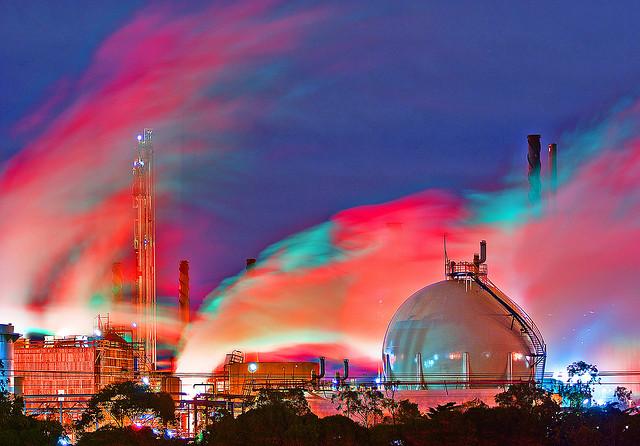
Some analysts have recently observed that Australia isn’t complying with its International Energy Agency obligations—it’s the only member of the International Energy Agency (IEA) that doesn’t have a 90-day supply of strategic petroleum reserves. But aside from the fact that Australia isn’t living up to an international agreement, just how vulnerable does that lack of reserves make Australia? Coming up with an answer isn’t easy—assessments are mixed, and the data contested. Still, overall, Australia’s energy vulnerability seems to be getting worse, not better.
When Andrew Davies and Edward Mortimer assessed this issue back in 2011, they concluded that Australia’s vulnerability in the next five years would be low, even without a strategic reserve, largely because of a diversity of suppliers in the market. Further, they demonstrated that strategic reserves held by other countries had a marginal impact on helping to sort out shocks in in the system, again, largely because of the diversity in suppliers. They did, however, predict that in the medium term (5 to 25 years), things weren’t so rosy—because of a gradually increasing concentration of suppliers. Just four years later, their predictions about increasing vulnerability appear to be coming true.
A series of reports on Australia’s liquid fuel security published in 2013 and 2014 by the NRMA are frightening. Australia’s suffering from an ever-increasing reliance on imported liquid fossil fuels and a declining domestic refining capacity. The reports explain that 90% of Australia’s domestic transport liquid fuels are imported. There are multiple critical links in the supply chain, all the way from the source to the consumer. Each of those links is vulnerable to the influence of malign actors, disasters, even sensitivities in the world’s banking, financial and insurance systems. The reports further explain that Australia’s quickly moving toward a situation where by 2030 it’ll have no domestic refining capability, less than 20 days of fuel in the supply system (including corporate reserves), and a 100% import dependency. That means that if the supply gets interrupted, Australia will have a matter of weeks to sort it out before experiencing economic consequences. Some estimates of the severity of such consequences can be found here and here.
Perhaps the most vulnerable choke points in the international oil supply system are the Straits of Hormuz and Malacca. Together, about 57% of the world’s maritime oil trade moves through those two locations. Much of Australia’s liquid fuel supply comes through one or both. The statistics can be confusing as one source claims that only 37% of Australia’s liquid fuel comes from the Middle East (and therefore must pass through Hormuz). Yet, as the number of Australian refineries quickly dwindles toward zero in 2030 (see the NRMA reports), Australia must rely on the refineries of other Asian countries (see here and here) who are much more dependent upon Middle-East oil. Japan, South Korea, and Singapore all rely on Middle-East crude for over 80% of their refined product. As we become more reliant on their refineries we inherit that dependency.
Many reports offer recommendations on how to address Australia’s energy vulnerabilities. The NRMA reports have some useful suggestions such as including the rebuilding of strategic reserves. They also recommend other actions such as reducing liquid fuel demand, diversifying the sources of transportation fuel, and building a domestic refining capacity. Mark Thomson and Robert Clark show that diversifying to domestically-available liquid natural gas can help. Engineers Australia also published a comprehensive report that examines Australia’s energy security vulnerability beyond just the issue of strategic reserves and liquid fuel security.
But, when it comes to strategic reserves, how valuable are they? The US has a government-run strategic petroleum reserve system that seemed to come in handy after natural disasters (like Hurricane Katrina in 2005) severely reduced supply. Yet Davies and Mortimer in their report in 2011 provided evidence that the resilience of the US economy had little to do with the release of reserves and more to do with the breadth and depth of the American petroleum industry and its ability to source products on the world market. But that was due in part to the fact that the US petroleum reserves were in crude oil not in refined product. The US had some refining capacity still left and Katrina didn’t hit the rest of the world or interrupt a key choke point. If Australia is left with no refineries, 100% dependence on imported refined product, more than 80% of which comes first through the straits of Hormuz, and no strategic reserves of refined product on hand, the outcome might be more stressful. So, how vulnerable is Australia and what’s being done about it?
Certainly Australia’s defence spending and its commitment to the US alliance helps to secure the global commons and thereby mitigate threats to this apparent vulnerability. Yet, a comprehensive national security strategy should seek to fix vulnerabilities and not just protect them from threats. If that’s the case, other questions need to be asked and answered. How much would it cost to build and fill strategic petroleum reserves? And, just as importantly, what’s the opportunity cost of doing so? The cost of building and filling strategic reserves should be measured against other government funding priorities.
Lieutenant Colonel Jan K. Gleiman is an active duty US Army officer and a visiting fellow at ASPI from United States Pacific Command. These are his personal views. Image courtesy of Flickr user Paul Hocksenar.